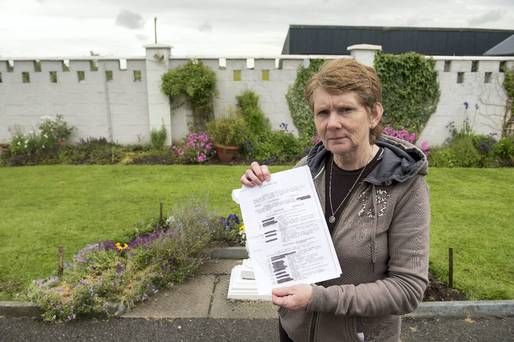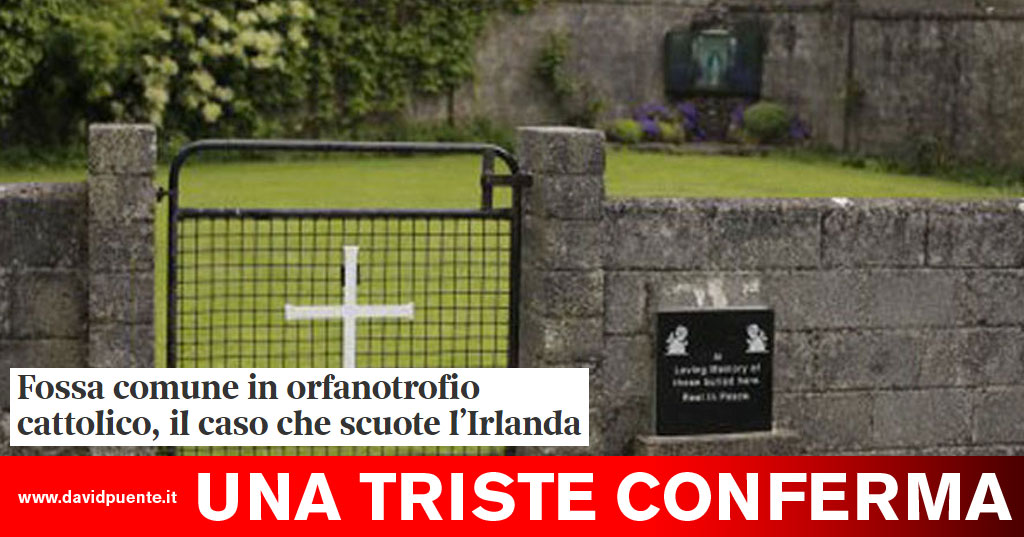Nel 2014 circolò la notizia che all’interno di un orfanotrofio cattolico irlandese situato a Tuam venne trovata una fossa comune con ben 800 cadaveri, ma all’epoca fu scorretto parlarne perché non venne rilevato alcunché. Siccome bisogna ricostruire tutta la storia, riporto di seguito una sintesi seguita dall’analisi completa.
Sintesi
Nel 2014 venne diffusa la notizia del presunto ritrovamento di una fossa comune presso un’orfanotrofio cattolico irlandese con circa 800 cadaveri di bambini. In verità non ci fu alcun ritrovamento, ma soltanto la denuncia di una ricercatrice (Catherine Corless) che non riusciva a comprendere come mai a Tuam (Irlanda) fossero state registrati 796 decessi di minori e non fossero riscontrabili in alcun modo le loro sepolture. Il tutto venne etichettato come “bufala”, ma si trattava di disinformazione visto che non venne trovato nulla e si interpretarono in malo modo le dichiarazioni della ricercatrice. A seguito di quei fatti, una commissione governativa indagò a fondo e soltanto nel 2017 venne resa pubblica la scoperta di una ventina di stanze fognarie sotterranee contenenti diverse “centinaia” di cadaveri di età compresa tra le 35 settimane e i 3 anni. A dare ulteriore conferma è il ministro irlandese Katherine Zappone (“Minister for Children and Youth Affairs“).
Analisi
La voce circolò in seguito alle dichiarazioni di una ricercatrice di nome Catherine Corless che non parlò di 796 cadaveri (i media arrotondarono), ma di 796 bambini morti durante la loro permanenza nella struttura di cui mancava la documentazione funeraria. Tradotto: le morti erano certificate, ma le tombe? Dove erano stati sepolti? C’è stato un funerale?
Ecco quanto riportato dall’Irishtimes nel 2014:
The deaths of these 796 children are not in doubt. Their numbers are a stark reflection of a period in Ireland when infant mortality in general was very much higher than today, particularly in institutions, where infection spread rapidly. At times during those 36 years the Tuam home housed more than 200 children and 100 mothers, plus those who worked there, according to records Corless has found.
[…]
She also discovered that there were no burial records for the children and that they had not been interred in any of the local public cemeteries. In her article she concludes that many of the children were buried in an unofficial graveyard at the rear of the former home. This small grassy space has been attended for decades by local people, who have planted roses and other flowers there, and put up a grotto in one corner.
All’epoca chiesero scusa in molti, tra i quali anche Associated Press. Questa storia venne erroneamente etichettata come “bufala”, siccome si trattava di un caso di disinformazione dovuta ad un errata interpretazione delle dichiarazioni della ricercatrice irlandese. Spiego meglio: non venne trovata una fossa comune con 796 cadaveri di bambini nel 2014, la loro morte non era messa in dubbio bensì il luogo dove sarebbero “sepolti”.
Nel 2015 la stessa ricercatrice tornò a parlare del caso al The Guardian nell’articolo intitolato “The mystery of the missing remains of the Tuam babies” (“Il mistero dei mancati resti dei bambini di Tuam“).

Il 3 marzo 2017, a distanza di circa quattro anni, si torna a parlare di questa “fantasiosa” fossa comune che, purtroppo, viene a galla. Ecco quanto riportato dal The Guardian:
A mass grave containing the remains of babies and children has been discovered at a former Catholic care home in Ireland where it has been alleged up to 800 died, government-appointed investigators said on Friday.
Excavations at the site of the former Bon Secours Mother and Baby Home in Tuam, County Galway, have uncovered an underground structure divided into 20 chambers containing “significant quantities of human remains”, the judge-led mother and baby homes commission said.
The commission said analysis of selected remains revealed ages of the deceased ranged from 35 weeks to three years old. It found that the dead had been mostly buried in the 1950s, when the facility was one of more than a dozen in Ireland offering shelter to orphans, unmarried mothers and their children. The Tuam home closed in 1961.
[…]
The Irish government in 2014 formed the commission following the work of a local Tuam historian, Catherine Corless, who found death certificates for nearly 800 children who were residents at the facility but burial records for only two.
[…]
The government’s commissioner for children, Katherine Zappone, said the findings were “sad and disturbing” and promised that the children’s families would be consulted on providing proper burials and other memorials.
Insomma, dopo qualche anno dalle denunce di Catherine Corless si è giunti alla scoperta, grazie agli scavi e alle indagini svolte dagli investigatori nominati dal governo irlandese (che istituì un’apposita commissione), di una struttura sotterranea suddivisa in 20 stanze fognarie contenenti “significative quantità di resti umani” di età compresa tra le 35 settimane e i tre anni. I bambini sarebbero morti intorno al 1950, quando l’orfanotrofio era in attività (chiuse nel 1961).
Ne parla nuovamente anche l’Irishtimes il 4 marzo 2017:
The remains were contained in at least 17 of 20 underground chambers in what appeared to be a sewage-related structure. It is understood the initial investigation confirmed several hundred bodies located there.
[…]
Galway-based researcher and historian Catherine Corless said the announcement had vindicated her work, which uncovered death certificates for 796 children at the Bon Secours-run Tuam home.
“This is only the start. The truth has been revealed,” she said.
Una triste conferma delle denunce lanciate dalla ricercatrice irlandese. Si parla di “centinaia” di corpi, ma non viene riportato un numero esatto (non sappiamo se sono i famosi 796 o più o meno). Questo è un problema perché qualche testata italiana potrebbe essere contestata in merito a quanto riportato dai loro titoli:
- Irlanda, confermata la presenza di 800 bimbi sepolti nell’istituto delle suore di Tuam (IlFattoQuotidiano, 3 marzo 2017)
- Irlanda, una fossa comune con 800 cadaveri di bambini nell’orfanotrofio (LiberoQuotidiano, 4 marzo 2017)
- Irlanda, fossa comune vicino ad un ex istituto religioso con i cadaveri di 800 bambini (Repubblica, 3 marzo 2017)
- La fossa comune degli 800 piccoli irlandesi. Svelato l’orrore dell’orfanotrofio cattolico (La Stampa, 4 marzo 2017)
- Irlanda, scoperte fosse con 800 bimbi morti in orfanotrofio (La7, 4 marzo 2017)
- Irlanda, trovata una fossa comune con 800 corpi in un ex orfanatrofio religioso (Il Giornale, 3 marzo 2017)
Il ministro irldandese Katherine Zappone (“Minister for Children and Youth Affairs“) nel post Facebook del 3 marzo 2017 racconta del lavoro svolto dalla commissione, elogiandone l’operato. Ecco il testo completo:
Statement by Dr Katherine Zappone TD, Minister for Children and Youth Affairs
Commission of Investigation into Mother and Baby Homes
Excavations at Tuam, Co. GalwayThe Commission of Investigation into Mother and Baby Homes has informed me of an important development in relation to excavations it carried out in Tuam Co. Galway.
As we know, mother and baby homes came to public attention in the summer of 2014 following a series of disturbing reports of high mortality rates and claims of possible burials of children on the grounds of the former Mother and Baby Home in Tuam Co. Galway. The then Government decided to have these matters investigated and a statutory Commission of Investigation was established in February 2015.
Since that date, the Commission has been examining a wide range of concerns related to the institutional care of unmarried mothers and their babies during the period 1922 to 1998. The Commission is examining 14 Mother and Baby Homes and 4 County Homes. It will in time provide a full account of what happened to vulnerable women and children in these institutions; how they came to be there; and the pathways they took as they left.
An early focus of the Commission’s work was to examine the Tuam site to address questions about the alleged interment of human remains. As part of this process, the Commission conducted a series of surveys and test excavations, commencing last October and concluding recently. I visited the site myself and met former residents and relatives shortly before these works commenced.
As announced on the Commission’s website today, it has confirmed the presence of human remains on the site of the former Bon Secours Mother and Baby Home in Tuam, Co. Galway. The Home was run by the Bon Secours Sisters from 1925-1961 in what was previously a workhouse dating back to famine times. In the 1970’s the former home was demolished to make way for a local authority housing estate. A small memorial garden is maintained by local residents and there is also a children’s playground on the site.
The Commission’s excavations have revealed that human remains are visible in a series of chambers that may have formed part of sewage treatment works for the Home. It is not certain whether the chambers ever functioned for sewage purposes, but the Commission believes that there are a significant number of children’s remains there. The Commission recovered some juvenile remains for detailed forensic analysis. From this analysis, it has determined that the remains are between 35 foetal weeks and 2 to 3 years of age. From carbon dating it has correlated the age of these samples with the time period during which the home was in operation – between 1925 and 1961.
This news is very disturbing and will touch everyone’s heart. There were, of course, strong suspicions about burials of this kind in Tuam for some time, and it was one of the reasons for setting up the Commission of Investigation in the first place. The information I have received confirms these suspicions and, importantly, they trace the remains specifically to the period of the Home’s operation, rather than to earlier times in our history such as during the Famine.
In the first instance, I believe that today is about acknowledging what has occurred. Our first concern must be to respect the dignity and the memory of the children who lived their short lives in this Home.
But the Government is very mindful too about the questions that people will have, and what should happen next.
Before I say more about this, I want to thank the Commission for its important work on this matter. This is very much an interim stage in its deliberations. The Commission was anxious to bring this to our attention now. It will continue its work in relation to its overall terms of reference, including the wider practices and procedures that were applied to burials and other matters relating to deaths that occurred in these homes.
The Commission has already notified the local coroner in north Galway of its findings, and Galway County Council is aware of the matter also. We have now put in place a series of actions to ensure that we have an appropriate and respectful response to the discovery.
Firstly, having been notified by the Commission of its discoveries, the Coroner for North Galway will consider what steps may be necessary and appropriate in accordance with his statutory functions, on the basis of the information now made available. He is of course independent in the discharge of these functions. It is open to the coroner to call on the support of the Gardaí and any other authorities as he may deem necessary.
Secondly, Galway County Council and the Commission of Investigation will engage in relation to the next steps on the site, now that the Commission’s excavations have been concluded. Importantly, the site has been made secure pending any further decision.
Thirdly, and critically, Galway County Council will engage with local residents and other interested parties on what should happen next in relation to the remains. There are a number of possible options, such as re-interring the remains elsewhere, or making a decision to leave them undisturbed. I am acutely conscious of the sensitivities that will arise in this regard, and I realise that there may be sincerely held but differing views on what is the best way forward.
The Government is very anxious to ensure that all decisions are taken in an appropriate, respectful manner that honours the dignity of these children. The question of an appropriate form of memorial or memorial rite will perhaps also arise in this context.
No doubt there will be many questions asked in the coming days and weeks about this shocking discovery. Some of these can be answered now, but no doubt many more will not, at least for now. There will be an information line in operation from today to answer queries from members of the public, and to direct their queries to the appropriate agencies. We also have arrangements in place for people who have been affected by these issues, through the HSE Information Line.
While the Commission has concluded its work in relation to the excavations at Tuam, it has not yet reached any formal conclusions about the site, such as whether the burial arrangements were in line with the laws or practices of that time – which would of course be very different today. The Commission will continue its wider work on such matters as post mortem practices and procedures, reporting and burial arrangements for residents of Mother and Baby Homes.
I think it may take some time to make final decisions about these matters, but a key concern is that we have an appropriate consultation process that gives everyone affected an opportunity to give their views. I very much hope that it will be possible to arrive at a consensus, so that we can move forward on an agreed path together.
My Department held a meeting of all the key Departments and agencies yesterday, including the Departments of the Taoiseach; Housing, Planning, Community and Local Government; Justice and Equality; Health; and the Attorney General’s Office; as well as Galway County Council and An Garda Síochána.
We will continue to work together to ensure that we have a sensitive and respectful response to this reminder of our country’s lack of compassion for the young girls, women and children who were in these homes.
Altri dati vengono forniti nell’articolo del collega Michelangelo su Butac.
Extra
Alcuni siti italiani hanno etichettato il tutto come una “fake news” considerando le notizie relative al 2014 o parlando d’altro:
- Fossa comune dell’orfanotrofio una fake news. Anche Tg1 in grave errore (Intelligonews.it, 5 marzo 2017)
- La fossa comune nell’orfanotrofio cattolico? Occhio alla bufala… (Uccronline.it, 4 marzo 2017)
Leggiamo quanto riportato da UCCR:
Si legge ovunque il termine “fossa comune”, ma le autorità di Dublino non hanno affatto parlato in questi termini. La stessa storica locale che ha portato avanti l’inchiesta, Caterina Corless, è intervenuta sull’Irish times dicendo: «Non ho mai usato la parola “scaricati”, non ho mai detto a nessuno che 800 corpi sono stati gettati in una fossa settica. Non sono le mie parole». La fossa comune è una buca in cui vengono gettati sbrigativamente cadaveri di più persone, senza alcuna segnalazione della loro morte. Nel caso dell’istituto irlandese, invece, per tutti i bambini deceduti è stato compilato un certificato di morte ed è grazie ad esso che Catherine Corless ha potuto segnalare anni fa la presenza di 800 bambini seppelliti. La storica ha spiegato che nei certificati compilati dalle religiose, compaiono i nomi dei bambini, la loro età, il luogo di nascita e le cause di morte. I documenti, inoltre, mostrano che molti bambini dell’orfanotrofio sono stati battezzati. Il numero medio annuale di morti nei 36 anni è stato poco più di 22 all’anno.
La difesa dell’UCCR e di siti come Catholicleague.org riguarda l’uso della definizione “fosse comuni“. Questo, per il sito cattolico, basta per definire tutto una “fake news“:
It was a lie in 2014 and it is a lie in 2017. There is no evidence of a mass grave outside a home for unmarried women operated by nuns in Tuam, Ireland, near Galway, in the 20th century. The hoax is now back again, and an obliging media are running with the story as if it were true.
[…]
Ireland’s Mother and Baby Commission completed its inquiry into this issue and released a statement on March 3rd about its findings today. The probe was a response to allegations made by a local historian, Catherine Corless, who claimed that 800 babies were buried in a tank outside the former Mother and Baby home that was operated by the Bon Secours nuns.
Parlare di “fosse comuni” non sarebbe del tutto errato in questo caso, infatti i luoghi riscontrati (una ventina di stanze fognarie sotterranee) possono essere considerati tali in merito alla descrizione “luogo dove venivano sepolti i cadaveri di persone povere che non potevano permettersi un monumento funebre o una sepoltura individuale“. Quando si parla di “fosse comuni” si pensa subito al periodo delle guerre e ai genocidi, ma non è questo il caso perché di fosse comuni si registrano anche ad episodi legati a catastrofi naturali o epidemie.
Condivido solo una cosa: ritengo sia inutile e dannoso prendersela contro la Chiesa Cattolica o contro i cattolici, sapete come la penso su chi fa di tutta l’erba un fascio.

